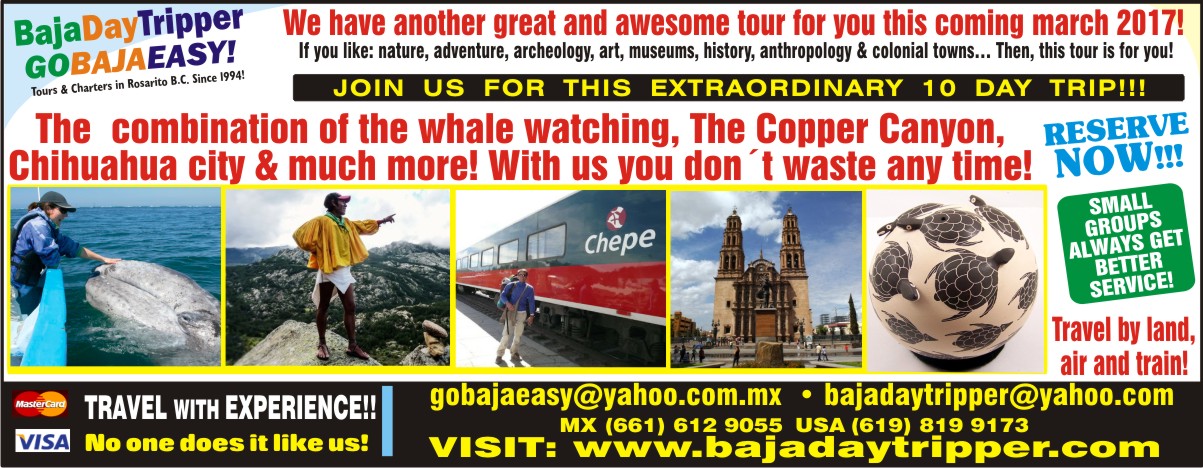You Must Try This incredible Combination with us!
2022, Special Departure
Please @ us for more details!
Limited Seating! 10 day tour!
Visit awesome Mexico as never before!!
Where can you experience ocean, desert, mountains, valleys, modern cities, colonial towns, huge canyons, unique rock formations, high desert, and archaeological ruins while traveling comfortably in cars, boats, trains, and planes in an exciting journey of only ten days?
Every day is unique, with no repeats, as you traverse the states of Baja California (North & South), Sinaloa, and Chihuahua, Mexico.
Located in the Central Desert of Baja California, we will visit the cave paintings of Cataviña, surrounded by hundreds of magnificent, building sized boulders and gigantic rock formations that will absolutely amaze you. This area is also known as Baja’s Rock Garden and you will certainly know why. These paintings tell the story of indigenous life (The Cochimi Indians), both human and animal, that existed in this region more than 2,000 years ago.
Whale watching is available from many places but only in Baja California can you touch a whale. While in a boat launch, driven by an experienced captain, you will be closer than you ever imagined to the whales and will have the best opportunity possible to touch them. It is one of the thrills of a lifetime.
Los Mochis is a coastal city in northern Sinaloa and is the western terminus of the Chihuahua-Pacific Railroad, or El Chepe, which passes through the scenic Copper Canyon. This railway was conceived by Albert K. Owen as a trade route linking the cattle markets in Kansas City with the port of Topolobampo, which is the second natural deep water port in the world. There is a lot to say about Los Mochis, it’s land is amongst the most fertile ones in the country, contains over 70% of all irrigated land and producing sugar cane, cotton, rice, flowers, many types of vegetables, mangos, etc. and lately the tourism industry has become an important part of the economy. The port of Topolobampo offers a great opportunity for eco-tourism activities like: deep sea fishing and its waters provide most of the seafood sold in the state. A nearby beach Maviri, offers superb white sand beaches and calm safe water for swimming and water sports. The people from Sinaloa have a predominantly mixed heritage that includes native Indians (predominantly Mayos), Europeans, Americans and Asian.
El Fuerte is a delightful colonial town. Our hotel, Posada del Hidalgo, the legendary birthplace of the real Zorro, has modern, comfortable rooms with a historic ambience. The pueblo’s large central plaza is a few steps from the historic hotel.
Copper Canyon is larger, wider, and deeper than the Grand Canyon and more spectacular! This trip takes you to the best overlooks for viewing the Copper Canyon. There are several opportunities to meet Tarahumara Indians and see the caves where and how they live. At the Adventure Park, perched on the rim of the Canyon, you can enjoy the scenic beauty of the area or have one of the most exciting experiences of your lifetime. The Park offers panoramic views of the Canyon from multiple lookouts. Stand on the glass floor in the welcome center and look straight down into the chasm! Ride the cable car, suspended in the middle of the Canyon as you go from point to point. Even more exhilarating is the Zipline ride across the Canyon. It is a never to be forgotten experience.
From the high mountains and canyons you will travel to the tropical depths of Batopilas, from Pine trees to mangos! Batopilas, known as the “Treasure of the Sierra Madre”, was founded in 1709. In 1880, a former Mayor of Washington, D.C., Alexander Shepherd, purchased a mine in Batopilas and moved his family to the town. Eventually Shepherd owned some of the wealthiest silver mines in the world and the Sheperd Mansion is on the tour.
Nearby the town of Creel, we visit the waterfall, “Basaseachic” which is more than 800 ft. tall, the second tallest in Mexico.
The city of Chihuahua is the capital of the largest state in Mexico. The Cathedral, impressive both for its size and colonial architecture, is located in the central plaza of the city. Quinta Gameros, with its romantic history, is an exceptional example of architecture, both inside and out. The dining room, brought from Mexico City, is a stunning example of Art Nouveau. Walk in the footsteps of Pancho Villa when you visit the home of Luz Corral and Pancho Villa. Photographs of famous American screen stars grace the walls, mementos of their visits to Villa’s widow. The Governor’s Palace hosts extensive murals in the Mexican tradition that illustrate the history of Chihuahua and of the Mexican people, including Geronimo, Apaches, Pancho Villa, great generals and heroes of Mexican Independence.
In contrast, Paquimé, on the UNESCO World Heritage list, is a large archeological site in NW Chihuahua from the 14th/15th centuries. It was a major link in trade between the Pueblo culture of the SW U.S., N. Mexico and the advanced civilizations of Mesoamerica. It vanished at the time of the Spanish Conquest and remains a mystery. The site is estimated to contain the ruins of about 2,000 rooms—living quarters, workshops and stores. Near Paquimé, the town of Mata Ortiz is famous for its production of pottery created in the pre-Hispanic style of Paquimé. Juan Quezada was inspired by pottery shards that he found around Mata Ortiz and in the 1970’s he began, as a self-taught artist, to produce pottery. Juan Quezada became famous and his work has appeared in major museums across the world. He has, in turn, inspired his pueblo and today Mata Ortiz is full of potters and other artists. As a contemporary link to the past, Mata Ortiz is a fitting culmination to your trip through the unique Mexican cultures that range from the Pacific to the high desert of Chihuahua.
